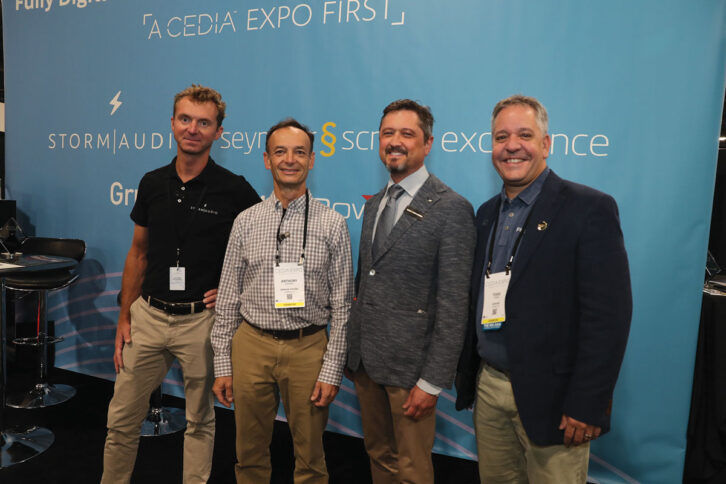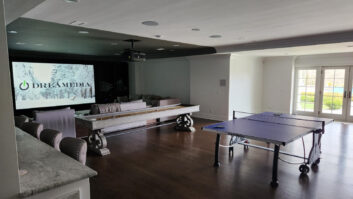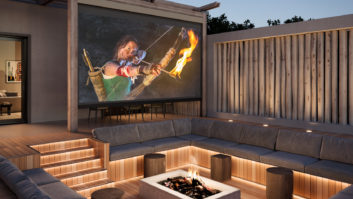You’re standing in the equipment room staring at the back of the rack. You’ve just finished racking up the AV controller and amplifiers for the massive 24- or 32-channel immersive sound system in the theater, and now you’re suddenly confronted with a multitude of XLR analog connections between the controller and amplifiers.
Oof. There are so many! Such a risk of a bad cable. Or a bad connector hastily assembled with a cold solder joint. Thin wires that break at the screw terminals of a Phoenix. Gain and impedance mismatching. Ground loops, noise, interference…the list goes on. This is the Hydra of analog cable bundles. And you’re not Hercules.
Well, wait, now — maybe you are. No, you’re not a demigod and you don’t have supernatural powers, but you do have a secret weapon in AES67. Great! That’s fantastic! We’re all set. Um…what exactly is AES67?

AES67 is an Audio-over-IP (AoIP) solution developed by the Audio Engineering Society that carries uncompressed digital audio over an Ethernet network. A single Cat6 can support a large number of high-resolution, uncompressed channels — more than enough to service even the largest Dolby, IMAX, or DTS-format immersive home theaters.
You get a network switch, connect it to the AV controller and amplifiers with Cat6, assign each controller output to the appropriate amplifier channel, and you’re done! I could stop here and we could all go grab a snack, but it’s a little more complicated than that.
Think about how much easier this could make everyone’s lives: Installation is so much simpler and your install crews can work faster, with dramatically fewer opportunities for screw-ups that cost time and money to find and fix.
Plus, the signal stays digital all the way from the source to the amplifier. You don’t have to worry about analog interfaces or D/A conversion until the very last moment, when the amp converts to analog right before the power stage. You want expandability? If you need to add more channels at the last minute, you don’t have to reinvent the entire rack. Just run one more Cat6 to the new amps and assign it to the new channels.
We usually stick to home theater in this column, but I’m sure you can see the application to whole-house distributed audio. The ability to interconnect devices flung around the house with the range and flexibility of a Cat6 network? I’ll leave the rest to your imagination.
Okay, so there are a few things to keep in mind. Obviously, you’re going to need to bring the networking team in on this because it is Audio over IP. For simpler systems, you can just go with a basic general-purpose network switch. For more advanced setups, you’ll need a managed switch. Some companies make dedicated switches for AoIP/AES67; that tells you how important this trend is!
I do recommend keeping the audio network isolated from the various data networks running elsewhere. You can run the audio on the data network, but the risk of conflicts is higher. Unfortunately, Wi-Fi is also not advisable for AoIP.
There’s also a relative lack of AV controller and amplifier products with AES67 in the consumer sector at present. It’s most likely to be found on high-end AV controllers that support high channel counts, but there’s some question as to which ones actually have it working. I can vouch for StormAudio (more on that in a minute). I like to be forward-thinking, but I don’t see consumer electronics companies rushing to AES67 (it has been around for ten years, after all) — especially not amplifier companies that are now faced with building digital processing front-ends into their amplifiers. If you like the idea of AES67, you can help the adoption process by making an appeal to your favorite vendors.
Also by Anthony Grimani: Get Centered
Meanwhile, there are products available on the commercial integration and professional audio side of things, and they can be used just fine in the highest-grade consumer systems. You may have to wade through a list of names that are unfamiliar at first; however, there are a lot of good resources at your fingertips. Just Google AES67. Look specifically for guides, diagrams, and tutorials on how to set up a studio using AES67. Studio work is really where AES67 lives, but you can apply those principles to audio distribution for home theater or whole house.
There are some other AoIP solutions out there, like Dante, Ravenna, etc. These work within networks where all the devices are talking the same protocol; AES67 works to bridge between those protocols (or work with each device natively), which is why I propose to favor AES67.
As I’m writing this, we’re preparing to do a demo, along with StormAudio, of an 11.6.6 Grimani Systems immersive room at CEDIA Expo 2023 in Denver. This system is going to feature full AES67 connectivity by using Powersoft amplifier modules, and we’re very excited about that. By the time you read this, CEDIA will be over. We hope you had the chance to see the demo!

Realistically, any solution that increases productivity and improves quality is worth a serious look, and AES67 really can do that for you. Look it up. Give it a chance. Try it out!
Anthony Grimani is co-founder of Grimani Systems loudspeakers (www.grimanisystems.com), and president of PMI Engineering (www.pmiltd.com) and MSR Acoustics (www.msr-inc.com). Chase Walton contributed to this column.






